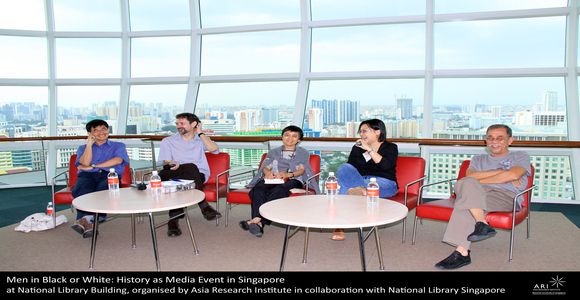Men in White silent on key historical issues, say schol
-
Men in White silent on key historical issues, say scholars
Saturday, 23 January 2010, 1:57 am | 0 views

Wong Chun Han / Pictures courtesy of Asia Research Institute, NUS
Rather than shedding light on the unfamiliar chapters of Singapore’s political history, the authors and publishers of Men in White have kept readers in the dark in some regards, scholars argued.
According to literature scholar Philip Holden and historian Hong Lysa, significant historical silences were evident in the 692-page tome on the history of the People’s Action Party published last September by Singapore Press Holdings.
Particularly noteworthy was the book’s failure to discuss important political issues such as merger with Malaysia and women’s rights, said the scholars at the National Library last Saturday.
Their assessments were well-received by over 100 people in attendance at ‘Men in Black or White: History as Media Event in Singapore’, a public seminar jointly organised by the National University of Singapore’s Asia Research Institute and the National Library.
Billed by organisers as the first public forum to examine Men in White as “a sensation generated from the intersection between history and the mass media”, the seminar assembled three speakers – Holden, Hong and former Straits Times journalist Tan Tarn How – to critique the book and the media attention on its publication.
 Approaching from a historian’s perspective, Hong, an independent scholar and former member of the NUS History department, criticised the book’s inadequate discussion of the issue of merger with Malaysia.
Approaching from a historian’s perspective, Hong, an independent scholar and former member of the NUS History department, criticised the book’s inadequate discussion of the issue of merger with Malaysia.The political, social and economic implications of the merger were not discussed, despite their central importance to Singaporean and PAP history of the 1960s, said Hong. Also notably absent were clarifications about the specific motivations of the 13 PAP legislative assemblymen who abstained on the motion of confidence on the government in July 1961.
Hong also noted the book’s particular concern for the political events of the 1950s and 1960s and the question of whether Lim Chin Siong and other Barisan Socialis members were communists. This, she suggested, may represent an attempt by the book’s authors to dismiss the story of the PAP’s “sullied birth”.
The arrest of leading Barisan Socialis members during Operation Coldstore in February 1963 would have blemished the PAP electoral victory in September, if those arrested were not branded as communist subversives. Questions would thus have remained over the legitimacy of the PAP’s victory, which arguably was facilitated by the weakening of the Barisan Socialis, she explained.
The book’s silence on significant political events and themes was also a letdown for Holden, an associate professor with the NUS English language and literature department.
Particularly disappointing for him was the failure to discuss events like the PAP’s resignation from Socialist International in 1976, Devan Nair’s resignation from the Presidency in 1985 and Operation Spectrum in 1987.
Holden also noted the superficial involvement of women in the Men in White narrative. Issues of gender equality were not discussed, nor were there any mention of the Women’s Charter, which passed into law in 1961. Notable female PAP members such as Dr Aline Wong were omitted altogether.
Women were reduced to mere signs, he argued, serving as symbols of social progress rather than historical actors in the PAP story, and providing a foil for men to define themselves against.
Suggesting that this could be the result of an unconscious reversion to gender stereotypes by the authors, Holden felt that the book and its title was underpinned by a definition of masculinity as the possession of integrity and character – qualities which those who oppose the PAP are alleged to lack.
Besides these omissions in the book, there were also issues with how Men in White was presented and discussed in the media, according to Tan, a senior research fellow at the Institute of Policy Studies studying Singapore’s media and arts policy.
Although conceding that the Straits Times was capable of good journalism when not restrained by government and corporate interests, he felt that its reporting in this instance was “mostly PR and not journalism”.
Noting that the total SPH coverage of Men in White amounted to about 50,000 words, he described the effort as “extensive” and “breathless”, carrying “a warm fuzzyness” about it.
 In contrast, the SPH coverage of the publication of The Fajar Generation, a collection of essays by former members of the University of Malaya Socialist Club, “never really engaged with what is being said [in the book]” and avoided discussing its content, said Tan.
In contrast, the SPH coverage of the publication of The Fajar Generation, a collection of essays by former members of the University of Malaya Socialist Club, “never really engaged with what is being said [in the book]” and avoided discussing its content, said Tan.He argued, extrapolating from the example of the Men in White coverage, that both the local mainstream and online alternative media lacked “thickness” in its content, being in want for richness, quantity and quality.
Tan, who spent 16 years with the Straits Times, concluded his prognosis with a caution, calling for wariness of the media’s “omissions in deed and in writing”.
-
Who knows MIW more than LKY? He lives in it, so if he vetted and endorsed the books, what the hack all those historians are trying to do, LKY is still alive ok.
-
the night of the long knifes! familiar? that how NAZI got into power. that is history!